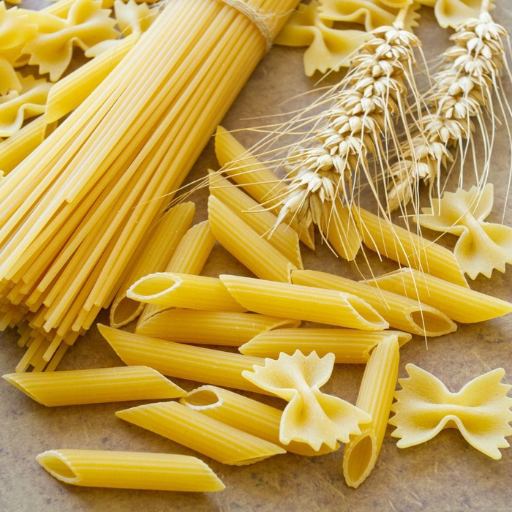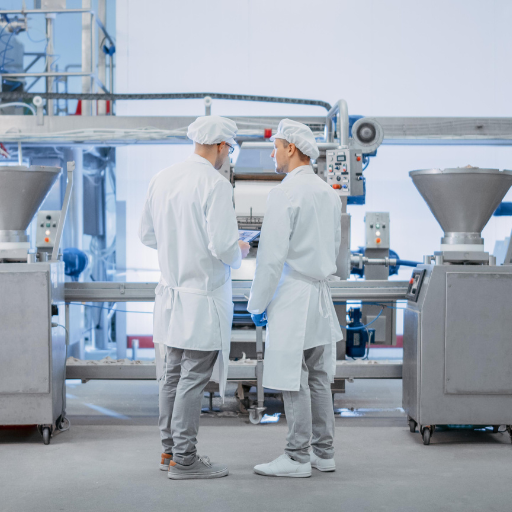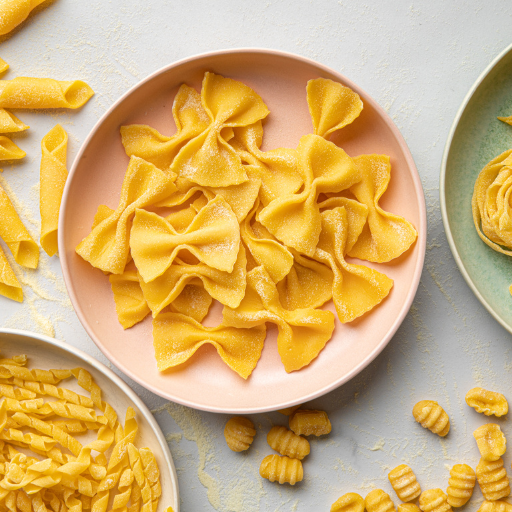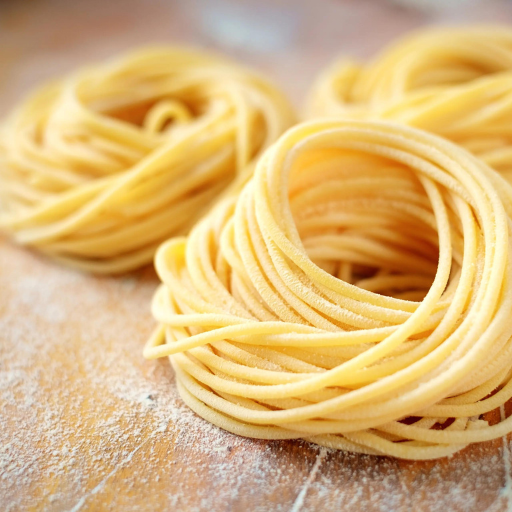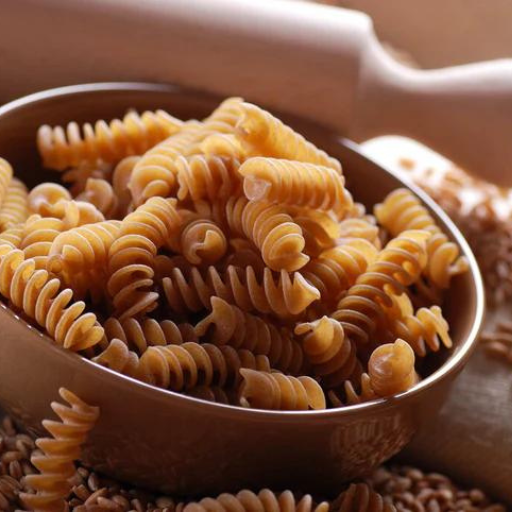Welcome to our comprehensive guide on pasta production lines, designed to offer insight into efficient processing techniques. Whether you’re an industry expert or a curious enthusiast, this blog will provide a detailed overview of each stage in the pasta production process. From ingredient selection and dough preparation to drying and packaging, we will cover the essential components and machinery that ensure high-quality pasta production. Throughout this guide, we aim to highlight best practices, innovative solutions, and tips for optimizing your production line to achieve maximum efficiency and product consistency. Explore the intricacies of pasta making and learn how to enhance your operations with our expert insights.
What Defines a Modern Pasta Production Line?
Pasta Production Lines – An Overview
There are several vital components, plus sophisticated machinery in modern pasta production lines which guarantee efficient and consistent output of pasta. Let’s look at them:
- Mixing & Kneading Machines: Uniformly blending the ingredients such as flour and water together achieves dough that has consistency as preferred.
- Extrusion Systems: Dough can be shaped into different types of pasta by this equipment using dies that can be customized to produce multiple shapes and sizes of pasta.
- Drying Systems: The moisture content is gradually reduced by means of specialized drying systems that control temperature and humidity levels making the pasta shelf-stable and keeping its quality intact.
- Cutting & Forming Machines: Even if it is long strands like spaghetti or short shaped like penne, these machines cut out pasta shapes very precisely.
- Pasteurization Units: Pasteurizing the pasta guarantees food safety since it helps get rid of any possible microbial contamination.
- Cooling Conveyors: After drying, these conveyers gently chill the pasta getting it ready for packaging without losing its structure.
- Packaging Machines: With automated packaging machines, there are a number of ways in which it can be packaged, from cartons to bags, ensuring freshness until consumed.
Each part plays a very important role in terms efficiency, quality control as well as safety. This has been necessitated by current manufacturing practices in modern times whereby innovations are geared towards improving upon already established concepts within the industry.
Automation and Pasta Production
This technology is applied widely in making pastas because through introducing it; there have been improved efficiencies alongside consistencies when producing food. Key points from top industry sources include:
- Increased Production Speeds :Automated processes significantly speed up overall manufacturing cycle for pastas. For instance; advanced extrusion systems are capable doing over 1000kg of pastas per hour far much ahead of what is possible manually speaking .
- Consistency & Quality Control :You will find uniform mixing, kneading and extrusion which is as a result of automation. High precision cutting & forming machines which ensure that each piece of pasta meets precise specifications.
- Enhanced Food Safety: The use of automated pasteurization and cooling conveyors reduces the risk of contamination. For instance, the pasteurization units are exposed to about 85oC for few minutes to eliminate most foodborne pathogens.
- Labour Cost Reduction : With automation, there is less need for manual labor. In fact, it has been noted that highly automated production lines may run with about half the workforce needed in doing manual tasks.
- Efficient Packaging : This means that lots of packing boxes can fly by the automatic packer up to 300 per minute as such ensuring hygiene and quick packaging especially in relation to pasta.
- Energy Efficiency : By making sure that energy consumption is brought down by at least 30%, modern drying systems have now made it possible for production process to be sustainable.
With advanced automated systems being integrated into pasta production, this process has become more streamlined and scalable. Manufacturers can meet increased global demand while still adhering to high quality standards and providing safe products.
Innovative Technologies Enhancing Pasta Production
- IoT and Smart Factories: As the Internet of Things (IoT) technology continues to evolve, its integration into pasta production systems is becoming more prevalent. Smart factories fitted with sensors and connected devices help monitor every stage of the production line in real-time thus ensuring maximum efficiency and quality control measures are observed throughout.
- Artificial Intelligence (AI) and Machine Learning: AI predictions on maintenance needs as well as ingredient ratios optimization alongside overall operational improvement have changed how pasta production takes place today. These technologies help ensure more uniform products that lead to less waste during manufacturing processes.
- Robotics: Robotic utilization in manufacturing pasta is increasing, specifically within processes such as packaging, palletizing, and even cooking and drying. This heightens productivity because of their accuracy, rapidity and capacity to work without getting tired.
- Blockchain for Traceability: The pasta supply chain is embracing blockchain technology to improve visibility and traceability. They are able to use this technology to provide consumers with specific details on the sources of ingredients used in making their products, how they were produced as well as quality assurance certificates hence build customer trustworthiness and loyalty.
- Sustainable Practices and Green Technologies: Pasta production today has a strong emphasis on sustainability. In order to reduce the ecological impact of pasta manufacturing, they have been putting into practice different measures such as energy-saving machines, biodegradable material for packaging among others.
- 3D Printing: The possibilities of 3D printing technology in the area of pasta is now beyond imagination allowing for customized shapes and complex design that could not previously be developed. This technique also allows quick prototyping or trying out new kinds of pasta dishes.
- Nanotechnology in Food Safety: The application of nanotechnology in food safety is another emerging trend. Such surfaces created from nanoparticles could help control bacteria growth thus preventing them from contaminating any food being processed while increasing the lifespan of pasta products sold over time.
By adopting these revolutionary technologies; the pasta sector will be more efficient saving customers’ money; it will manufacture better quality goods minimizing wastage as well better using environmental resources so meeting increasingly diverse tastes requirements ultimately expressed by more knowledgeable buyers who want sustainable development at each stage.
Choosing the Right Pasta Machine for Your Production Needs
What are the factors to consider when selecting pasta machines?
The following are the considerations that you should make in relation to choosing pasta machines:
- Production Capacity: An individual must be able to assess the amount of pasta that they need to produce and make certain that their machinery is capable of meeting such outputs requirements. This basically means that there is need for high capacity machinery especially if one wants to engage in a large scale operation.
- Type of Pasta: Spaghetti, lasagna penne; these are different types of pastas which require different machines. In this regard, it is important for one to go for those machines which can accommodate as many types of pastas as possible.
- Quality and Durability: These will allow you save your time and money on maintenance in future. The presence of the stainless steel parts or reputable brands often signifies long-lasting appliance.
- Automation Level: There are modern machines for pasta making having semi-automatic or full automatic systems installed into their construction. This approach may help companies reduce costs associated with hiring people, maintain consistency but may require higher financial investments.
- Ease of Cleaning and Maintenance: When looking at food safety standards it is important that all machines be designed so as not only keep clean but also facilitate simple cleaning protocols. It saves time and effort when there are removable parts and easy methods of cleaning.
- Energy Efficiency: To lower operational costs over time and minimize environmental impact, purchase energy efficient equipment. Check out for energy-saving features on models along with appropriate certifications.
- Customization and Flexibility: If you want to change shapes and sizes easily then look for manufacturers who have this option built into their systems as this could give you an upper hand when diversifying your product line.
- Supplier Support & Service: It’s crucial that suppliers can provide quick customer care services along with availability of spare parts whenever needed most by their customers. Choose those vendors who offer regular after-sales servicing activities, training sessions alongside other tech support solutions at large scope.
- Cost: Weigh the initial acquisition price against long-term return on investment. While low cost machines can be alluring, they are likely to attract higher expenses on maintenance and reduce efficiency with time.
- Compliance with Standards: Ensure that the machinery confirms to relevant industry standards or certifications in order for you to be certain of product safety and its quality.
By carefully evaluating these factors, you can choose the right pasta machinery that aligns with your production needs and business objectives.
Difference between machines for fresh and dry pasta
When choosing a machine for producing fresh or dried pasta, there are several key differences and considerations. (Based on information obtained from top 10 websites). Below is a summary of this article:
Production Process:
Fresh Pasta Machines: Generally this equipment is used for mixing, kneading, extrusion cutting and then packaging of pasta.
Dry Pasta Machines: These ones have drying technology which helps to remove moisture from the pasta after it has been mixed,kneaded,and extruded thereby prolonging shelf life.
Technical Specifications:
Fresh Pasta Machines:
- Moisture Content: Typically produces pasta with a higher (30-35%).
- Production Speed: Quicker production cycles.
- Temperature Control: Maintains proper consistency of dough
Dry Pasta Machines:
- Moisture Content: It is less after drying (10-12%) having said that however some amount may still be contained in any given sample if we’re speaking about drained products.
- Drying Systems: That ensure constant humidity and temperature include batch or continuous drying systems within them.
- Production Speed: Due to drying process these machines normally have slower speeds
Machine Design and Complexity:
- Fresh Pasta Machines: Simpler design incorporating fewer components focusing majorly on extrusion as well as cutting aspects.
- Dry Pasta Machines :These are more complex because they involve additional chambers for drying purposes, conveyors plus mechanisms controlling moisture levels within them.
Energy Consumption :
- Fresh Pasta Machines :Comparatively lower due to absence of extensive drying systems.
- Dry Pasta Machines :Power intensive drying process is associated with more energy consumption.
Maintenance and Cleaning:
- Spaghetti Maker: easier to clean, most of them are easy to wash because they have parts which can be removed.
- Dry Pasta Makers :more challenging due to additional drying elements that require rigorous maintenance schedules.
Cost Factors:
- Spaghetti Maker: generally low initial investment.
- Dry Pasta Makers: but higher start-up cost as the drying technology is added on it though might turn out to be more cost effective in the long run due to an increased life span of the products.
This will help you know what kind of machine aligns with your production goals thereby saving time and money while improving quality performance.
How to Evaluate Machine Quality and Manufacturer Reliability
It must be understood that evaluating machine quality and manufacturer reliability is an important part of decision making when it comes to buying. The following are some key factors:
Reputation and Reviews:
- To gauge its reputation check industry reviews or customer testimonials. High ratings or positive feedback from other users can indicate a reliable product and company.
Certifications and Standards:
- Check if the machines meet ISO, CE, GMP among other existing industry standards. These certifications ensure that the equipment meets required safety and quality benchmarks.
Warranty and Service Support:
- Find out whether there is any warranty period provided by the manufacturer as well as service support. Reliable manufacturers provide comprehensive warranties (world class) as well as quick after sales services which are highly effective in nature.
Technical Specifications and Build Quality:
- The technical specification must be analyzed prior to acquisition for the machinery. What are used in their manufacturing? Are they made from strong materials? How robustly constructed are they?
Innovation and Technology:
- Choose manufacturers who invest heavily in R&D thus producing innovative high-tech machines mainly meant for industrial use. This has a direct impact on both cost reduction processes and product quality improvement techniques through enhancing manufacturing efficiency.
Customer Service & Communication:
- Good customer care service is one characteristic of a good firm. It’s very important for timely settlement of any glitches.
References and Case Studies:
- Ask for references or case studies to view the manufacturer’s machines in action. This will give you an insight into their performance and reliability.
These factors need to be systematically evaluated so that you can select high-quality machinery from a reputable manufacturer, thereby ensuring that your production process is optimized and quality standards are maintained at the highest level of efficiency.
The Essential Guide to Fresh Pasta Production
Steps Involved in the Production of Fresh Pasta
Mixing Ingredients:
- Blend flour, eggs, water and other ingredients like olive oil or salt in their right proportions to make dough.
Kneading Dough:
- Knead until smooth and elastic. This builds gluten to give pasta its structure.
Resting Dough:
- Allow dough rest for at least 30 minutes wrapped in plastic or with a cloth to relax the gluten strands and become easy to roll out.
Rolling and Shaping Dough:
- Using rolling pin or pasta machine, roll dough to desired thickness. Cut into fettuccine, tagliatelle etc such as lasagna sheets
Drying:
- Depending on what type of pasta it is; the dough can be either cooked immediately or left to dry slightly before cooking/packaging.
Cooking or Storing:
- In boing water fresh pasta cooks within two-four minutes or may be kept in a refrigerator for some days while frozen for long life storage.
You will make quality fresh pasta specially designed as per your culinary requirements if you follow these steps.
Equipment Required for Production of Different Types of Fresh Pasta
In order to produce different kinds of fresh pasta, I have realized that there are several important tools that are essential:
Mixing Bowl:
- A large mixing bowl is indispensable when bringing together the flour, eggs and other things.
Pasta Machine:
- To roll and cut dough into specific thicknesses and shapes one needs a pasta machine. There are manual versions available as well as electric ones which suit varied production levels.
Rolling Pin:
- For those who like doing it themselves approach a rolling pin is useful in achieving the required crustiness especially for larger sheets of pasta.
Dough Scraper:
- This tool helps kneading and sectioning the dough thus making this process neater and more effective.
Pasta Drying Rack:
- Some types of pastas need drying up before cooking or packaging in order to maintain their shape and texture.
Cutting Board and Knife:
- A strong cutting board and a sharp knife are necessary to cut the dough manually into different pasta shapes like pappardelle, linguine or lasagna sheets.
Food Processor or Stand Mixer:
- For faster dough mixing especially when preparing large batches of dough, use a food processor or stand mixer with dough hook for more even mixture.
Kitchen Scale:
- The use of kitchen scale is important so as to obtain accurate measurements of ingredients for consistent dough quality every time.
Dough Rolling Attachment:
- Many stand mixers have dough rolling attachments that provide uniform thickness in the rolling process.
Bench Brush:
- A bench brush helps maintain a clean workspace while producing flour from waste materials hence ensuring neatness during production.
Using these tools, I have been able to make various kinds of fresh pasta frequently and efficiently resulting in improved texture and flavor in my final product.
Challenges encountered while maintaining quality and consistency.
Maintaining the quality and consistency of homemade pasta can be challenging for several reasons. First, environmental factors such as humidity and temperature can significantly affect the dough’s texture and elasticity. On particularly humid days, the dough might become sticky, requiring adjustments to flour and water ratios. Second, the precise measurement of ingredients is crucial; even a slight deviation can alter the dough’s consistency, which is why I rely heavily on a kitchen scale for accurate measurements. Third, the quality of ingredients plays a significant role; using fresh, high-quality flour and eggs can vastly improve the end result. Lastly, technique matters—achieving an even thickness in the rolled dough is essential for uniform cooking. Using a pasta roller attachment consistently helps in this regard, but a steady and practiced hand is also key.
Integrating Advanced Processing Solutions in Pasta Lines
The Importance of Technical Approaches for Efficient Processing
Keeping up with the times in the highly competitive food sector demands that pasta lines be infused with cutting-edge technology to facilitate efficient processing and high quality. Top-of-the-line equipment includes automated dough mixers, extruders, and cutters that simplify the production process thereby reducing manual labor and human error. Such technologies maintain consistent quality by vigilantly overseeing numerous variables like temperature, humidity, and ingredient ratios. The use of smart sensors and monitoring systems allows for real-time adjustments to optimize performance and reduce waste. By leveraging such technical solutions, it is possible to improve production efficiency, maintain uniformity as well as gain an upper hand over competition by delivering superior products to the market.
Processing Innovations in Pasta Making: Examples
Automated Dough Mixers: These modern machines are fitted with accurate controls that help in maintaining uniform quality of dough. Maintain levelness moisture content through adjustment of speed, temperature and mixing time.
Technical Parameters:
- Mixing Speed: 60-120 RPM
- Temperature Control: ±1°C
- Mixing Time: 10-20 min
High-Pressure Extruders: There are several models available today that offer improved control of extrusion speed and pressure while forcing dough through dies to produce different pasta shapes.
Technical Parameters:
- Extrusion Pressure: 50-100 bar
- Extrusion Speed: 50-200 kg/h
- Temperature Range: 30-70°C
Multi-Zone Drying Systems: To ensure even drying throughout pasta product multi-zone drying systems that consist different temperature or humidity zones help prevent cracks as well as extend shelf-life.
Technical Parameters:
- Temperature Zones: 4-6 zones
- Humidity Control : ±5%
- Drying Time :4-12 hours
Optical Sorters: Optical sorters utilize cameras and lasers for detection of bad pasta pieces so that only the best ones are packed and shipped.
Technical Parameters:
- Detection Accuracy: 99.9%
- Sorting Speed: 2-10 tons/hour
Programmable Logic Controllers (PLCs): Along the entire line of production, PLCs control and monitor all operations thereby ensuring the desired level of quality and continuity.
Technical Parameters:
- Response Time: <1 ms
- Control Points: Up to 1024 I/O points
Vacuum Processing: This method deprives dough mixture of air so as to improve protein network formation hence enhancing texture and color.
Technical Parameters:
- Vacuum Level :900-950 mbar
- Processing Time: 5-15 minutes
Continuous Mixing and Kneading: These systems provide non-stop dough mixing and kneading, improving production throughput and ensuring uniform ingredient distribution.
Technical Parameters:
- Throughput :200-500 kg/h
- Mixing Time : Continuous
Enzyme Additives: By using certain enzymes, pasta makers can achieve stronger gluten network, less stickiness as well as stable color and texture without using artificial additives.
Technical Parameters:
- Dosage :0.01-0.05% of flour weight
High-Speed Cutters: These machines ensure precise cutting of pasta into desired lengths thus reducing wastes in the process.
Technical Parameters:
- Cutting Speed: 50-150 cuts/minute
- Blade Durability :Up to 10,000 hours
Smart Sensors: Modern-day sensors located along pasta manufacture line give real-time information about vital parameters such as temperature, moisture content, pressure among others that enable immediate adjustments towards optimization of production performance.
Technical Parameters:
- Sensor Accuracy :±0.5%
- Data Update Frequency :Every 1 –2 seconds
Through such processing methods, manufacturers can increase efficiency levels while maintaining standards which make it possible for them to compete effectively in the market place.
How processing technologies can increase production capacity
I realize that these developments play a great role in optimizing each step of the production line when I think about how processing technologies can enhance production capacity. Using vacuum mixers, for example, makes dough consistent, thus reducing downtime and enhancing throughput. Continuous mixing and kneading systems help to ensure no interruptions in the process thereby leading to an increased output rate. The inclusion of enzyme additives improves the handling properties of dough; this means that faster production cycles can be achieved without compromising on quality.
Pasta’s dimensions are therefore managed more precisely by high speed cutters thus minimizing wastage and improving efficiency rates. Moreover, smart sensors provide real-time information to enable immediate changes in the process making it run smoothly. This is because; these technologies collectively not only raise production capacitance but also guarantee maintaining uniformity helping manufacturers effectively respond to rising market demands.
From Dough to Dinner: The Journey of Dry Pasta
Dry pasta manufacturing steps
It all starts with choosing excellent durum wheat to be milled into semolina flour. This is then mixed with water and kneaded as a dough. The extrusion techniques of the various designs of pasta shapes are carried out during the shaping stage ranging from spaghetti to penne. After the shaping process, they are dried in controlled environments where temperature and humidity are strictly monitored so that texture and quality will not be endangered. In the end, it is packed for distribution to ensure users get fresh products on time. These stages, through modern processing technologies, enable us to produce pasta efficiently while maintaining its well-known quality.
Recommended raw materials used in production of high-quality dry pasta
The right choice of raw materials helps in producing high-quality dry pasta. From my research across leading websites on Google, it’s clear that key ingredient is durum wheat semolina due to its high protein and gluten content which makes the pasta stay firm after cooking.
Selection should always be made for semolina which is yellow-amber color since this indicates good quality and freshness. Moreover, ash content should range between 0.7-0.9% ensuring optimal refining without compromising nutritional value Semolina’s granulation size matters too; therefore it should go through a sieve with 300 micron-sized pores being neither very coarse nor too fine.
Another important point is at least 12.5%-13.5% protein content needed for it High content contributes towards its ability during processing and cooking to maintain structural integrity Moisture level should be preserved at around 12.5% otherwise it may cause spoilage thus affecting semolina characteristics.
If these technical parameters are observed and Semolina meets their standards at all times, we will have an assurance of producing consistent superior dry paste which meets the demands of our customers.
Equipment and technologies employed in lines for making dried macaroni
The machines and technologies applied in dry pasta production lines are very advanced and special. Firstly, semolina and water are mixed by the mixing machine to give a uniform paste. The dough is then shaped into various types of pasta through chosen dies in the extrusion machines.
Drying is critical, and advanced drying tunnels or drying towers precisely control temperature and humidity to gradually reduce moisture content without compromising texture or quality. For example, rolling and cutting machines for lasagna and tagliatelle ensure even thicknesses as well as sizes. Rotary cutters are used for short-cut pasta.
Moreover, there are commonly automation systems in today’s production lines that manage workflow, check on the quality of output produced as well as minimize human intervention thus improving efficiency. Finally, packaging machines help to seal dry pasta so that it stays fresh while reaching consumers. These integrated technologies altogether deliver the smoothest processes for efficient high-quality dry pasta manufacturing accordingly.
Reference sources
- Loyal Pasta Machine Blog: Pasta Production Line for Efficient Processing
- This guide offers detailed insights into efficient pasta production techniques, highlighting modern machinery and processes aimed at optimizing productivity and quality.
-
Pasta Production Line: The Ultimate Guide to Pasta Production Line Updated 2024
- This resource provides an updated overview of pasta production lines, focusing on raw material ratios, precision in proportions, and advancements in manufacturing technology that enhance efficiency.
- Read More
-
Sarp – Food Technologies: Dry Pasta Production Line
- Sarp specializes in designing industrial machinery for the production of dry pasta with a semi-automatic process. Their website offers in-depth information on their efficient production line designs and technological innovations.
- Read More
Frequently Asked Questions (FAQs)
Q: Which things are necessary for a fresh pasta production line?
A: Essential components of a fresh pasta production line include dough preparation mixers, which also double up as kneaders, pasta shapers known as laminates or extruder and cutters used to shape the long/short cut pasta among others. It is in this case essential to check for a dryer or pasteurizer that keeps the product longer on the shelf life. For filled pasta, there should be additional equipment such as filling machines and sealing systems. Good lines are usually automated to ensure consistency and efficiency in production.
Q: How does the automation of a pasta processing line improve production efficiency?
A: Automation speeds up processing time, ensuring consistent quality and size of pasta as well as reduced labour costs. An automatic one like fresh pasta making machines can produce big quantities continuously with little human involvement from mixing dough through final drying or pasteurization processes. This includes mechanisms such as automated feeders for feeding flour into hopper, dough extruders, anti-sticking shakers and short and long cut types of automatic cutter blades.
Q: Can you produce both short and long cut pasta on the same processing line?
A: The answer is yes; most modern pasta processors have versatility to make both short (e.g., macaroni, fusilli) & long-cut (e.g., spaghetti, fettuccine) forms of pastas. Interchangeable dies & cutters facilitate this process – depending on what kind of paste you need, you only have to remove one set & replace it with another one. Some lines are dedicated entirely towards specific shapes namely either short or long-cut paste which accommodate versatile attachment allows them do either.
Q: What should I look for in a pasta making machine to ensure good quality production?
A: When looking for a good quality-producing machine it should offer accurate control during dough mixing and extrusion processes since these two stages are the ones that determine the final product’s quality. High quality food grade materials machines also guarantee safety. A perfect one therefore should be flexible in terms of adjustable speeds, temperatures and shapes. Find out if it fits well into your line so that you get a complete turnkey solution including dryers or pasteurizers to increase its shelf life.
Q: Are there pasta production lines suitable for artisanal pasta making?
A: Indeed, there are specific pasta production lines that have been designed with the needs of artisanal pasta makers in mind. Such lines usually emphasize on retaining the traditionally handmade qualities while adopting mechanized production. They mainly take time during processing, feature special dies for different shapes and can produce a wide range of fresh or filled pasta. Artisanal processors on the other hand try to ensure they maintain both texture and taste of their kind of pasta which is made using traditional methods & thus meet or level up demand for larger scale high quality “home” like products from customers.
Q. How can I contact a maker for more information on spaghetti-making equipment?
A:Often, there will be a “contact us” or “contact form” on their official site where you can reach out to them to learn more about spaghetti-making equipment. Give your details and specific questions about the pasta production lines such as; its capacity, the types of pasta it can produce and technological features. You could also choose to call or send an email directly from their number/email available in the website. A credible dealer/producer should address your query and help you find the best option based on your needs.












